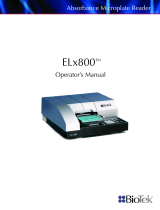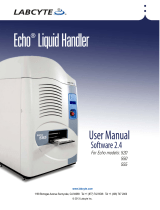Page is loading ...

Z’-LYTE® Compatible Microplate Reader
Documentation
Version No.:
6 Jan 10 Page 1 of 14
Setup Guide on the BMGLABTECH POLARstar Omega Microplate Reader
Have a question? Contact our Technical Support Team
NA: 800-955-6288 or INTL: 760-603-7200 Select option 3, ext. 40266 Email: drugdiscoverytech@invitrogen.com
Z’-LYTE® Assay Setup Guide on the
BMG LABTECH POLARstar Omega Microplate Reader
NOTE: The BMG LABTECH POLARstar Omega Microplate Reader was tested for
compatibility with Invitrogen's Z’-LYTE® Assay using the Z'-LYTE® Tyr6 kit (PV4122) against
JAK2 JH1/JH2 and JAK2 JH1/JH2 V617F kinases. The following document is intended to
demonstrate setup of this instrument and provide representative data. For more detailed
information and technical support of Invitrogen assays please call 1-800-955-6288, select
option "3", then extension 40266. For more detailed information and technical support of BMG
LABTECH instruments or software, please contact BMG LABTECH at 1-877-264-5227 or
www.bmglabtech.com.
A. Recommended Optics
wavelength (nm)
BMG LABTECH
Filters
Excitation
400
(or similar) *contact BMG LABTECH
Emission 1
460
(or similar) *contact BMG LABTECH
Emission 2
520
(or similar) *contact BMG LABTECH
B. Instrument Setup
1. Make certain plate reader is turned on, and open up Omega Control software on
computer. Insert plate into plate reader.

Z’-LYTE® Compatible Microplate Reader
Documentation
Version No.:
6 Jan 10 Page 2 of 14
Setup Guide on the BMGLABTECH POLARstar Omega Microplate Reader
Have a question? Contact our Technical Support Team
NA: 800-955-6288 or INTL: 760-603-7200 Select option 3, ext. 40266 Email: drugdiscoverytech@invitrogen.com
2. When Omega Control software opens, if you do not have a pre-existing protocol
for Z'-LYTE®, select "Test Protocol" from the “Test Setup” menu bar at the top of
the window.

Z’-LYTE® Compatible Microplate Reader
Documentation
Version No.:
6 Jan 10 Page 3 of 14
Setup Guide on the BMGLABTECH POLARstar Omega Microplate Reader
Have a question? Contact our Technical Support Team
NA: 800-955-6288 or INTL: 760-603-7200 Select option 3, ext. 40266 Email: drugdiscoverytech@invitrogen.com
3. At this point, a new screen will open (below). Click on the “Show all test
protocols” button on the left side of the screen, then select “New” from the tabs at
the bottom.

Z’-LYTE® Compatible Microplate Reader
Documentation
Version No.:
6 Jan 10 Page 4 of 14
Setup Guide on the BMGLABTECH POLARstar Omega Microplate Reader
Have a question? Contact our Technical Support Team
NA: 800-955-6288 or INTL: 760-603-7200 Select option 3, ext. 40266 Email: drugdiscoverytech@invitrogen.com
4. A new window will pop up. Select “Fluorescence Intensity” and “Endpoint” and
then select “OK”.

Z’-LYTE® Compatible Microplate Reader
Documentation
Version No.:
6 Jan 10 Page 5 of 14
Setup Guide on the BMGLABTECH POLARstar Omega Microplate Reader
Have a question? Contact our Technical Support Team
NA: 800-955-6288 or INTL: 760-603-7200 Select option 3, ext. 40266 Email: drugdiscoverytech@invitrogen.com
5. A new Protocol window will open automatically. Enter a test name, select plate
type, and select “Top optic” for the “Optic” type. Next, set the number of flashes
per well to 50. Finally, under "Filter Settings", check the “Simultaneous dual
emission” feature (note you must have 460 and 520 emission filters on opposite
sides of the emission filter wheel for this, for more advice on filter adjustments
contact BMG Labtech) and select your excitation and emission filters.

Z’-LYTE® Compatible Microplate Reader
Documentation
Version No.:
6 Jan 10 Page 6 of 14
Setup Guide on the BMGLABTECH POLARstar Omega Microplate Reader
Have a question? Contact our Technical Support Team
NA: 800-955-6288 or INTL: 760-603-7200 Select option 3, ext. 40266 Email: drugdiscoverytech@invitrogen.com
7. From the tabs along the top of this window, select "Layout". A new window will
appear. Select the wells you wish to read by highlighting them. When finished,
select "OK"

Z’-LYTE® Compatible Microplate Reader
Documentation
Version No.:
6 Jan 10 Page 7 of 14
Setup Guide on the BMGLABTECH POLARstar Omega Microplate Reader
Have a question? Contact our Technical Support Team
NA: 800-955-6288 or INTL: 760-603-7200 Select option 3, ext. 40266 Email: drugdiscoverytech@invitrogen.com
8. Selecting “OK” will cause the screen to return to the main window. From the top
menu bar go to “Measure” and select “Measure” from the drop-down menu.

Z’-LYTE® Compatible Microplate Reader
Documentation
Version No.:
6 Jan 10 Page 8 of 14
Setup Guide on the BMGLABTECH POLARstar Omega Microplate Reader
Have a question? Contact our Technical Support Team
NA: 800-955-6288 or INTL: 760-603-7200 Select option 3, ext. 40266 Email: drugdiscoverytech@invitrogen.com
9. Select the protocol you have just created. Click “OK”.

Z’-LYTE® Compatible Microplate Reader
Documentation
Version No.:
6 Jan 10 Page 9 of 14
Setup Guide on the BMGLABTECH POLARstar Omega Microplate Reader
Have a question? Contact our Technical Support Team
NA: 800-955-6288 or INTL: 760-603-7200 Select option 3, ext. 40266 Email: drugdiscoverytech@invitrogen.com
10. A new window will appear. Under the “Gain Adjustment” tab, select an
appropriate well to set your gain for each channel. Note in this case, a well in
Column 22 which was a no inhibitor (100% kinase activity) control well was
chosen to optimize the donor gain and a well from Column 23, which was the
kinase-free 0% phosphorylation control was chosen to optimize the acceptor
gain, this allowed us to set the gain for both donor and acceptor from wells where
we expect their maximal signal. After each well selection, highlight the channel
as shown on the left side of the plate map, click the “Gain Adjustment” tab, and
the instrument will calculate the gain. When both channels have been optimized,
select “Measure” to read plate.

Z’-LYTE® Compatible Microplate Reader
Documentation
Version No.:
6 Jan 10 Page 10 of 14
Setup Guide on the BMGLABTECH POLARstar Omega Microplate Reader
Have a question? Contact our Technical Support Team
NA: 800-955-6288 or INTL: 760-603-7200 Select option 3, ext. 40266 Email: drugdiscoverytech@invitrogen.com
11. When finished reading plate, select the Results tab from the drop-down menu
and then select “Open MARS Data Analysis Software” to view and analyze data.

Z’-LYTE® Compatible Microplate Reader
Documentation
Version No.:
6 Jan 10 Page 11 of 14
Setup Guide on the BMGLABTECH POLARstar Omega Microplate Reader
Have a question? Contact our Technical Support Team
NA: 800-955-6288 or INTL: 760-603-7200 Select option 3, ext. 40266 Email: drugdiscoverytech@invitrogen.com
C. Z'-LYTE® Kinase Assay using JAK2 JH1/JH2 and JAK2 JH1/JH2 V617F
NOTE: The following is a sample assay performed for demonstration purposes. The
section below describes how the data was obtained, and is not intended for use as an
assay protocol. We recommend all first-time users follow the appropriate protocols
and/or validation packets provided with their specific assay kits, and include all proper
controls. The instrument settings above would be sufficient for any Z'-LYTE® assay, the
information below is provided as representative data. Assay was run at the apparent
ATP Km concentration and a kinase concentration producing approximately 30-40% of
maximal phosphorylation, as discussed in Section 9 and 10 of the Z'-LYTE® protocols.
ATP and kinase concentrations should be optimized for each kinase by the actual user.
Specific Z’-LYTE® assay protocols and setup information from Invitrogen’s own in-house
SelectScreen® Custom Profiling Z’-LYTE®-based kinase assay service can be located at
the following link: http://www.invitrogen.com/content.cfm?pageid=9866.
1. Prepare initial 100X serial dilution curves in rows A and E of a 384-well plate:
Dilute Staurosporine and JAK2 Inhibitor II to a 100X initial concentration in 100%
DMSO (100 µM). Prepare a set of 1:1 serial dilutions from the initial
concentration in a 384-well plate, starting with 80 µl in Column 1 and 40 µl
DMSO in wells 2-20. Add 40 µl from well 1 to well 2, and then mix well 2, and
take 40 µl from well 2 and add to well 3, mix, and so on.
Figure 1: Schematic of initial compound dilution. Staurosporine and JAK2 Inhibitor
II were titrated from a 100 µM starting concentration in the initial dilution series by
preparing a 1:1 dilution curve in DMSO. A secondary dilution to 4X was then prepared
in the rows below the initial dilution curve (lighter gray) using kinase buffer.
2. The 100X serial dilution set is then diluted to a 4X working concentration in
Kinase Buffer (50 mM HEPES pH 7.5, 0.01% BRIJ-35, 10 mM MgCl2, 1 mM
EGTA) in the row below by adding 2 µl of diluted inhibitor from the well above to
123456789101112131415161718192021222324
Staur. 100X A
4X B
C
D
JAK2 Inh. II E
4X F
G
H
I
J
K
L
M
N
O
P

Z’-LYTE® Compatible Microplate Reader
Documentation
Version No.:
6 Jan 10 Page 12 of 14
Setup Guide on the BMGLABTECH POLARstar Omega Microplate Reader
Have a question? Contact our Technical Support Team
NA: 800-955-6288 or INTL: 760-603-7200 Select option 3, ext. 40266 Email: drugdiscoverytech@invitrogen.com
48 µl of kinase buffer. This will produce a final serial dilution starting at 4 µM,
which will then produce a final assay concentration starting at 1 µM.
3. Begin to prepare an assay plate: Add 2.5 µl of the compound dilutions per well
into a low volume NBS, 384-well plate (Corning Cat. # 3676), in quadruplicate so
rows A-D are staurosporine replicates, E-H are JAK2 Inhibitor 2 replicates, etc.
4. Add 2.5 µl of kinase buffer alone to rows 21 and 22 (0% inhibition no compound
control), 23 (0% phosphorylation control, no kinase added) and 24
(Phosphopeptide 100% phosphorylation positive control)
5. Add 5 µl of the 2X Peptide/Kinase Mixture (2 μM Tyr 06 peptide, 2600 ng/ml
JAK2 JH1/JH2 or 1300 ng/ml JAK2 JH1/JH2 V617F, determined experimentally
as outlined above) to Columns 1-22. DO NOT ADD TO COLUMN 23 OR 24.
Add 5 µl of 2μM substrate alone without kinase to Column 23, rows A-L (0%
phosphorylation control) and 5 µl of 2 µM phosphopeptide control substrate to
Column 24, rows A-L (100% phosphorylation control). Add 5 µl kinase buffer
alone to the remaining 8 wells (Columns 23 and 24, rows M-P) as a buffer-only
reference.
6. Add 2.5 µl of 4X ATP Solution (200 μM) per well to all Columns to start reaction.
7. Shake assay plate on a plate shaker for 30 seconds.
8. Incubate assay plate for 60 minutes at room temperature.
9. Add 5 µl of the Development Reagent Solution to each well. Use the lot-specific
dilutions indicated on your Certificate of Analysis (CoA) as dilution may vary
based upon Z'-LYTE® peptide and Development Reagent A lot.
10. Shake plate again on a plate shaker for 30 seconds.
11. Incubate for 60 minutes at room temperature.
12. Read and analyze as directed in the protocol.

Z’-LYTE® Compatible Microplate Reader
Documentation
Version No.:
6 Jan 10 Page 13 of 14
Setup Guide on the BMGLABTECH POLARstar Omega Microplate Reader
Have a question? Contact our Technical Support Team
NA: 800-955-6288 or INTL: 760-603-7200 Select option 3, ext. 40266 Email: drugdiscoverytech@invitrogen.com
Figure 2: Assay Plate Schematic. Compound titrations shown in Columns 1-20,
Columns 21 and 22 prepared without any inhibitor as kinase activity controls, Column
23 prepared with no kinase (0% phosphorylation) and Column 24 prepared using
phosphopeptide control (100% phosphorylation). Note 8 wells in gray in bottom right,
which were prepared with out any inhibitor or substrates, as buffer controls.
No Inh. 0 100
123456789101112131415161718192021222324
Staurosporine A
B
C
D
JAK2 Inh. II E
F
G
H
I
J
K
L
M
N
O
P

Z’-LYTE® Compatible Microplate Reader
Documentation
Version No.:
6 Jan 10 Page 14 of 14
Setup Guide on the BMGLABTECH POLARstar Omega Microplate Reader
Have a question? Contact our Technical Support Team
NA: 800-955-6288 or INTL: 760-603-7200 Select option 3, ext. 40266 Email: drugdiscoverytech@invitrogen.com
D. Results
Note: The results shown are meant as representative data only. The actual ratio values
obtained may vary from instrument to instrument. Values are dependent on multiple factors
including but not limited to the specific setup of each instrument, plate type and assay target.
Figure 1: Z'-LYTE® Kinase Assay. Z’-LYTE® assay performed using the BMG LABTECH
POLARstar Omega.
Z’ = 0.91
Z’ = 0.87
JAK2 JH1/JH2
0.001 0.01 0.1 110 100 1000 10000
1
2
3
4
5Staurosporine
Inhibitor Conc. (nM)
Ratio (460/520)
JAK2 JH1/JH2 V617F
0.001 0.01 0.1 110 100 1000 10000
1
2
3
4
5Staurosporine
Inhibitor Conc. (nM)
Ratio (460/520)
/


















